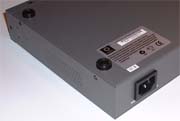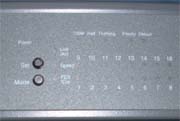Retail Value: $105
Product provided by: Compex
Setting Up
The Compex DSR2216 is designed to accommodate desktop or rack setup. Two mounting brackets and necessary screws are provided, but rubber feet are already attached. The mounting brackets attach to the switch with three holes on each side of the unit. The connection is quite secure, and not even a slight wobble was detected after rack-mounting the switch. A few extra screws would have been nice, in case a screw were to get stripped, or lost.
The switch uses a standard computer power cable (included), so there's no need to worry about an annoying AC adapter taking up three outlets on a power strip. Port 8 on the switch has an accompanying button for converting it to an uplink port, so integrating the switch into an existing network topology is as simple as a push of a button. The ports automatically negotiate the link speed at either 10 or 100 mbps, depending on whether 100 mbps is available or not.
Advanced Set-Up
The Compex DSR2216 offers greater functionality and customization than the basic switches used in most home networks. Advanced features of the switch include port prioritizing, port trunking, and forced mode for speed and duplex. All of these features are configured through sequences of pressing the two "power buttons" located on the unit's front.
It's not quite clear whether the "Power Buttons" are named such because they're located directly below the power LED indicator, or because their functionality is so powerful, but either way, they are accurately named. At first the daunting task of configuring a 16-port switch with only two buttons seemed nearly impossible. The interface and configuration is quite intuitive. As various modes of configuration are selected, the corresponding LED illuminates. The Set button is used to select different ports, and record changes. The Mode button is not only used to scroll through the different configuration modes, but to configure an option for a specific port once selected by the Set button. If desired, the included manual provides a brief, but acceptable description of how to configure various settings.
Certain ports can be given bandwidth priority over other ports through this method of configuration, and speed/duplex settings can also be manually specified per each port, if desired. One particularly important feature for expandability/scalability purposes is the integrated trunking support. While it's fairly common for 1-port cascading to appear on switches, the DSR2216 boasts support for 2, 3, or 4-port trunking as well. Trunking basically allows for multiple switches to be interconnected efficiently. With 1-port cascading, a maximum bandwidth of 200 mbps would be possible with one connection at 100 mbps full duplex. With 4-port cascading, a backbone of 800 mbps would exist between the two switches (with four ports on each switch operating at 100 mbps full duplex). This is important because bottlenecks can commonly occur between two switches, especially if 15 users on the switch needed to access a server which was only available on an adjacent switch, connected at 100 mbps full duplex. Despite the fact that all the users could access each other at theoretical speeds of 100 mbps full duplex, they would only have 1/15th of 100 mbps full duplex access to the server (translating to 6 2/3 mbps full duplex for each user). Despite the fact that a situation where all 15 users on the switch would actually need to simultaneously access the server in a high-bandwidth capacity, the bottleneck between the switches (and thus between the users and the server) is almost guaranteed to cause some slowdown in nearly all situations involving more than a few users.




